 DOCUMENT 3
DOCUMENT 3
FOI-24/25-0152
Research – Play and Climbing Equipment including Trampolines
(Residential and Community): Types, Safety, Restrictions, Lifespan,
Price Range, Maintenance, Purchase Accessibility, Ownership
Statistics and Community Playgrounds
Date
March 26, 2021
Requester(s)
Naomi
r
s47F - personal - Senior Technical Advisor (TAB/AAT)
Researcher
Craig
s47F - persona ( Tactical Research Advisor – TAB/AAT)
Cleared
Jane s47F - personal priv (Research Team Leader – TAB)
Research Brief
The Agency is seeing more and more requests for play/climbing equipment (including trampolines and
swings) that are common items that Australian households often purchase when they have children at
home.
To bolster this argument that it is related to a day to day living cost, the TAB is needing information,
including but not limited to the following:
•
How many types of play and climbing equipment are available? (Fixed, free standing etc.)
•
How many types of trampolines are available?
•
Do all of them have a safety rating?
•
Are there any restrictions recommended (i.e. only for certain weight/height etc.)
•
What is the general lifespan of the equipment?
•
What is the general price range of the equipment?
•
What is the general care/maintenance required of the equipment?
•
What is the accessibility for families to access the equipment (in store, online, special order etc.)
•
Are there any statistics informing how many Australian households have/own play equipment?
Are there any statistics informing how many playgrounds there are? (state by state)
•
How many are fenced?
•
How many feature disability specific equipment?
•
How many are shaded?
•
How often playgrounds are used by the community?
Please note:
The research and literature reviews collated by our TAB Research Team are not to be shared external to the Branch. These
are for internal TAB use only and are intended to assist our advisors with their reasonable and necessary decision-making.
Delegates have access to a wide variety of comprehensive guidance material. If Delegates require further information on
access or planning matters they are to call the TAPS line for advice.
The Research Team are unable to ensure that the information listed below provides an accurate & up-to-date snapshot of
these matters.
Research – Play and Climbing Equipment: General research and evidence of efficacy as an intervention
Page
1 of
20
Page 1 of 20

FOI-24/25-0152
1 Contents
2
Introduction .....................................................................................
Error! Bookmark not defined.
3
Related TAB Research ..................................................................................................................... 3
4
Summary ......................................................................................................................................... 3
5
Play & Climbing Equipment............................................................................................................. 4
5.1
Types ....................................................................................................................................... 4
5.2
Australian Standards & Safety Ratings .................................................................................... 5
5.2.1
Relevant Australian Standards ........................................................................................ 5
5.2.2
Trampolines .................................................................................................................... 6
5.2.3
Other Play Equipment ..................................................................................................... 6
5.3
Restrictions ............................................................................................................................. 6
5.3.1
Trampolines .................................................................................................................... 6
5.3.2
Other Play Equipment ..................................................................................................... 7
5.4
Price Range.............................................................................................................................. 8
5.4.1
Trampolines .................................................................................................................... 9
5.4.2
Other Play Equipment ..................................................................................................... 9
5.5
Lifespan ................................................................................................................................... 9
5.5.1
Trampolines .................................................................................................................... 9
5.5.2
Other Play Equipment ..................................................................................................... 9
5.6
Maintenance ......................................................................................................................... 10
5.6.1
Trampolines .................................................................................................................. 10
5.6.2
Other Play Equipment ................................................................................................... 10
5.7
Purchase Accessibility ........................................................................................................... 11
5.8
Ownership by Australian Households ................................................................................... 11
6
Community Playgrounds ............................................................................................................... 14
6.1
Australian Standards ............................................................................................................. 14
6.2
Statistical Information ........................................................................................................... 15
6.3
Maintenance and Safety ....................................................................................................... 15
6.4
Development of Inclusive Playgrounds in Australia ............................................................. 15
6.4.1
Visitation ....................................................................................................................... 15
6.4.2
Fencing .......................................................................................................................... 16
6.5
Tools to locate local community play grounds ..................................................................... 16
6.5.1
Searching the internet for local community playgrounds ............................................ 16
6.5.2
Specific inclusive playground websites ......................................................................... 17
Research – Play and Climbing Equipment: General research and evidence of efficacy as an intervention Page
2 of
20
Page 2 of 20

FOI-24/25-0152
7
Commercial Playgrounds and Services ............................................
Error! Bookmark not defined.
8
References .................................................................................................................................... 18
2 Related TAB Research
• NED20/381652: RES AAT THER
Climbing Therapy for Cerebral Palsy 2020/0122
• NED 21/93315: RES THER
Play and Climbing Equipment: evidence of efficacy as an
intervention 2021/178
3 Summary
Trampolines
• Domestic
trampolines in Australia do not have safety ratings. Australian trampoline
standard AS 4989:2015 is the standard pertaining to domestic trampolines. However it is
voluntary, and manufacturers are not required by law to meet the standard. (Note that the
TAB Research Team did not have access to any full text standards referenced in this paper)
• No specific information could be sourced on the
lifespan of trampolines
•
Trampolines don’t have height restrictions but do have
weight restrictions, which should be
indicated on the product. Rectangular trampolines can take on more weight than other
types.
Other restrictions on trampoline use is spatial, in terms of where the product is
placed for safety reasons
• There is a need for trampolines to be well
maintained for safety and lifespan reasons, which
may include regular servicing and replacements costs of various materials and fittings.
Various businesses offer regular maintenance check/makeover at cost.
•
Trampoline purchase accessibility by families is excellent
•
Trampoline pricing varies greatly depending on type and size, manufacturing materials,
where the overall price range is $159-$2,999
Other Play Equipment
• Other domestic paly equipment in Australia do not have safety ratings.
• No specific information could be sourced on the
lifespan of other play equipment
• No quality information or research could be sourced with regard to restrictions of other play
equipment. Like the trampoline, one could assume that weight and special restrictions
Research – Play and Climbing Equipment: General research and evidence of efficacy as an intervention Page
3 of
20
Page 3 of 20

FOI-24/25-0152
would apply.
• There is an abundance of information on the internet offering advice to consumers with
regard to the importance of care and maintenance of residential play equipment, in terms of
maintaining lifespan and safety. Unlike trampoline maintenance services, no services could
be sourced which offer at cost maintenance checks for other residential play equipment.
•
Other play equipment pricing varies greatly depending on type, size, style, and
manufacturing materials
Community Playgrounds
• Community/public playground equipment in Australia do not have safety ratings. Australian
Standard AS 4685.0:2017, Playground equipment and surfacing – Part 0: Development,
installation, inspection, maintenance and operation, is the standard pertaining to
commercial play grounds and equipment. The standard is not law, and not compulsory.
• There is an abundance of information on the internet offering advice to councils and
community playground operators with regard to the importance of care and maintenance of
grounds and play equipment. There are also businesses offering at cost services for
maintenance and standards checks.
• There is no consolidated statistical information available on community play grounds with
regard to number of playgrounds, fenced play areas, disability specific equipment, shaded
areas, and frequency of use.
• There are limited website directories providing listings of general and inclusive community
parks and playgrounds, and search engines appear to be the best means of locating this
information
4 Play & Climbing Equipment
4.1
Types
Residential outdoor play equipment/products can be broadly categorised into the following:
•
Slides (With/Without ladder)
•
Monkey Bars
•
Flying Fox
•
Cubby Houses
•
Swings
o Swing seats with ropes/chains
o Nest swings
Research – Play and Climbing Equipment: General research and evidence of efficacy as an intervention Page
4 of
20
Page 4 of 20
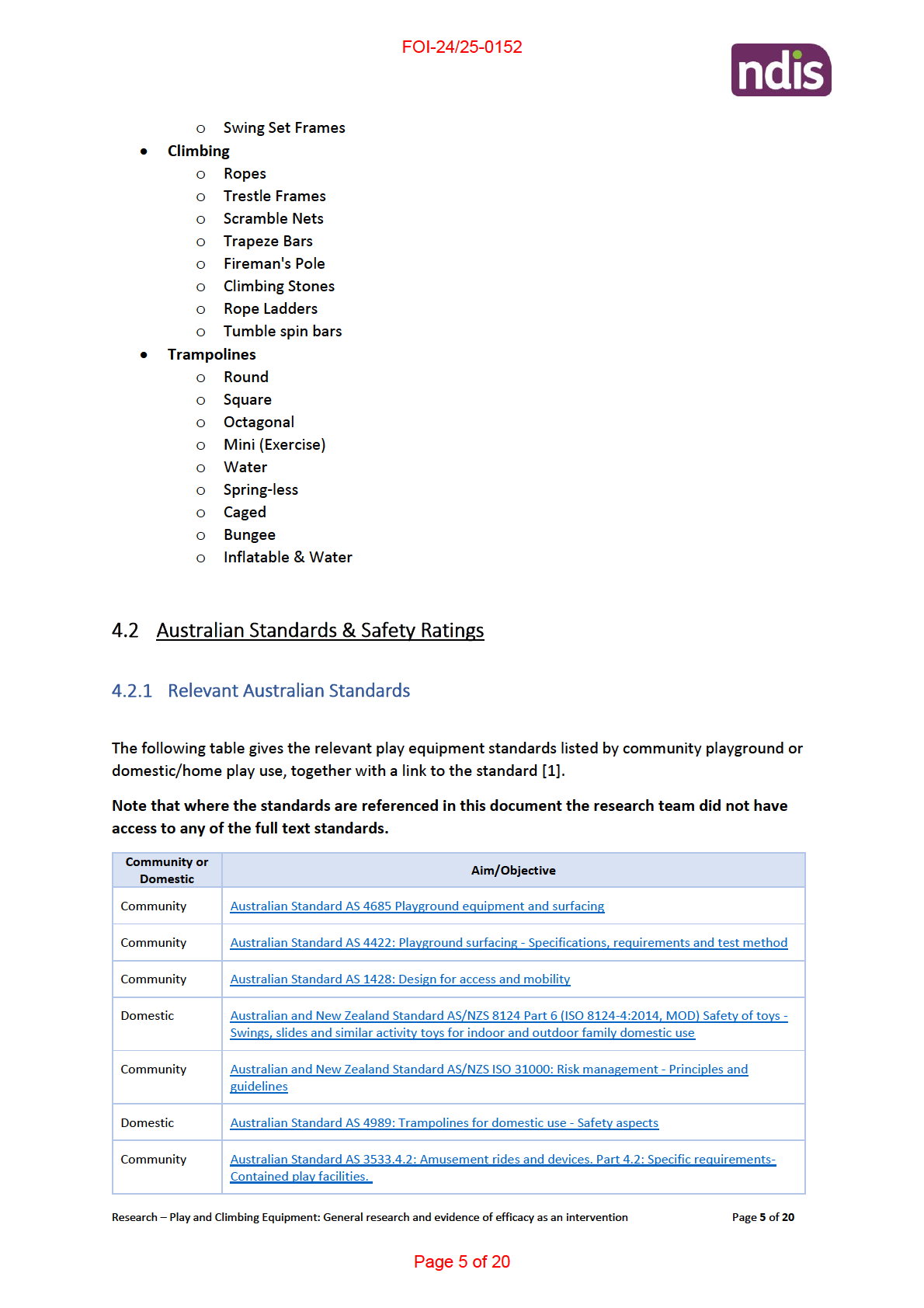

FOI-24/25-0152
4.2.2
Trampolines
Domestic trampolines in Australia do not have safety ratings. Australian trampoline standard AS
4989:2015 [2] is the standard pertaining to domestic trampolines. This standard is voluntary.
Manufacturers do not have to meet this standard, and they are not required by law to do so [3].
CHOICE consumer advocacy group carried out a recent test on 10 domestic trampolines looking at
safety and “how children can use the product in real life as well as how the trampoline performs if
you follow all safety instructions" [4]. They suggest that safety is based on safety padding,
enclosures, and ladders [3]. Only 1 trampoline passed their test which was the Springfree R79
Medium Round [5]. CHOICE also lists the trampoline models with serious safety issues as follows [4]:
• Kahuna Classic 10ft
• Kmart 12ft Springless
• Lifespan HyperJump3
• Little Nation 10ft Trampoline
• OzTrampolines Summit
• Plum Space Zone V3 30212
• Premier Trampolines 10ft Premier with Net & Ladder
• Vuly Thunder Medium
4.2.3
Other Play Equipment
Part 6 (ISO 8124-4:2014, MOD) of the Australian and New Zealand Standard AS/NZS 8124 applies to
the safety of toys - swings, slides and similar activity toys for indoor and outdoor family domestic use
[6]. This standard is not mandatory for the play equipment discussed in this paper, however, parts of
the standard is mandatory for toys mainly for children up to the age of 36 months [7].
4.3
Restrictions
4.3.1
Trampolines
No quality information or research could be sourced with regard to restrictions in using trampolines.
However, there is an abundance of information on the internet for the consumer to consider these
restrictions for equipment use in the home, and much of this information is from either play
advocacy type sites, state government, or equipment sales sites. Examples of weight and special
restrictions are below.
Research – Play and Climbing Equipment: General research and evidence of efficacy as an intervention Page
6 of
20
Page 6 of 20

FOI-24/25-0152
4.3.1.1 Weight Restrictions
While trampolines generally have no height restrictions placed on their use, but they do have weight
restrictions.
• The weight limits for a trampoline are based on the load capacity rating of the springs or the
support rods that are used in the product’s design. Exceeding those weight limits makes it
possible for the trampoline to break [8]
• The weight limit is referred to as the maximum weight capacity that a trampoline can hold. If
a trampoline features 350lbs weight limit, it means it will be safe for the jumpers who weigh
lower than 350lbs [9]
• There are two different weight limits for trampolines that are structural weight limit and
user weight limit. Weight capacity tells about trampolines strength and the users’ weight
capacity says how much maximum weight the trampoline can hold without any defects [9]
• How much weight a trampoline can handle depends on its size and shape, for example [10] :
o A round, eight-foot or 10-foot trampoline can typically handle 200 to 250 pounds.
o A round, 12-foot trampoline can typically handle 250 to 300 pounds.
o A round, 14-foot or 16-foot trampoline can typically handle 250 to 400 pounds.
o Regardless of size, most rectangular trampolines can handle between 300 and 450
pounds. Rectangular trampolines can take on more weight because of how the springs
work.
4.3.1.2 Spatial Restrictions
Trampolines range in sizes, from as small as 2.5m x 2.5m and as large as 4m x 4m. The jumping
surface (mat) can range from 54 square ft to 155 square ft. [11]. Springfree Trampoline (Australia)
makes the following suggestions as to how a trampoline should be placed [11]:
• Flat and even (if the space isn’t level, we recommend the rise/gradient be no more than 3
degrees across the whole space. We don’t advise installing where the slope is greater than
that)
• Safe lateral clearance space of 1.5m on all sides of the trampoline is highly recommended
• Minimum height clearance of 6m from the ground is highly recommended
• Clean and free of obstacles or debris
4.3.2
Other Play Equipment
Research – Play and Climbing Equipment: General research and evidence of efficacy as an intervention Page
7 of
20
Page 7 of 20
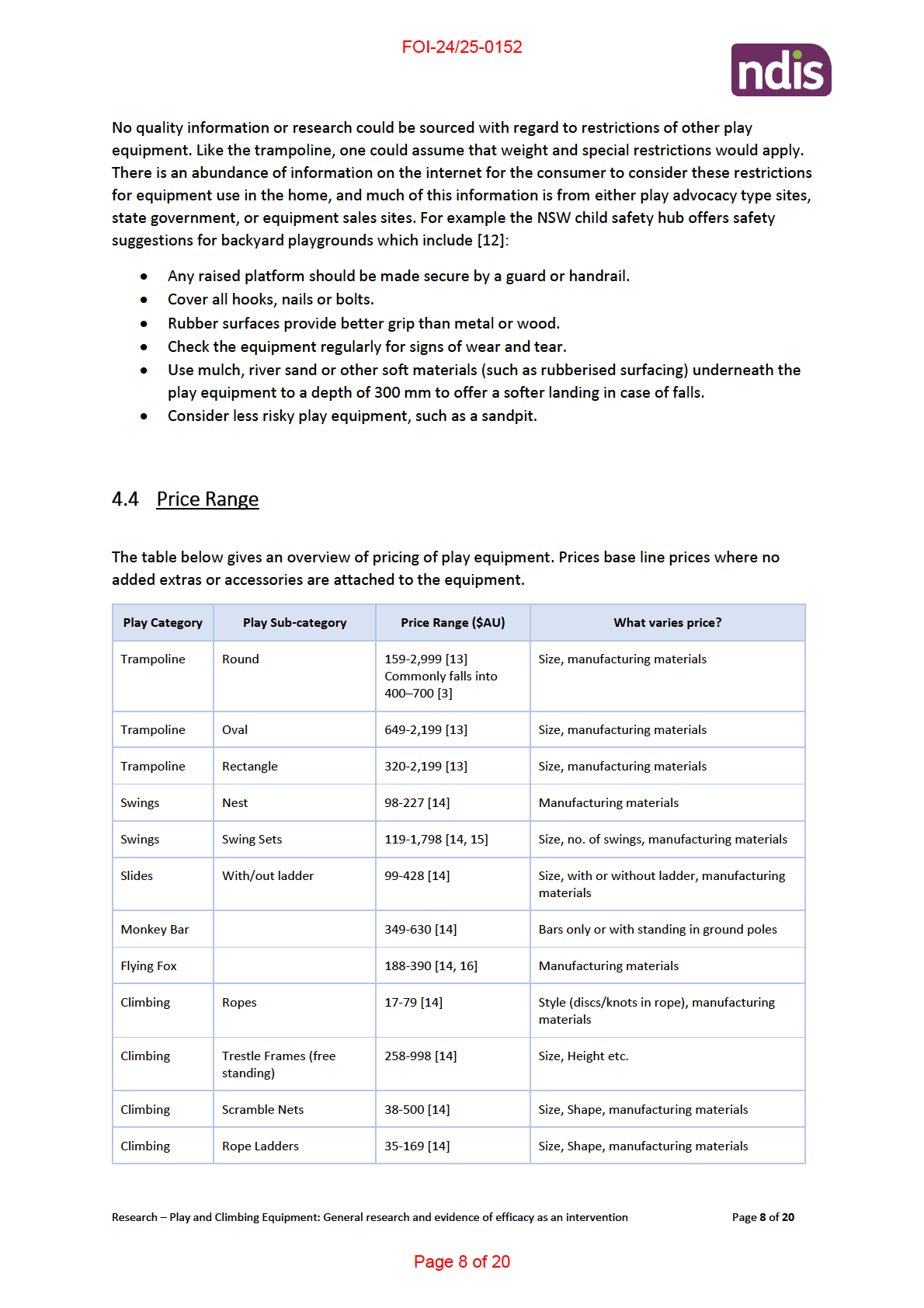
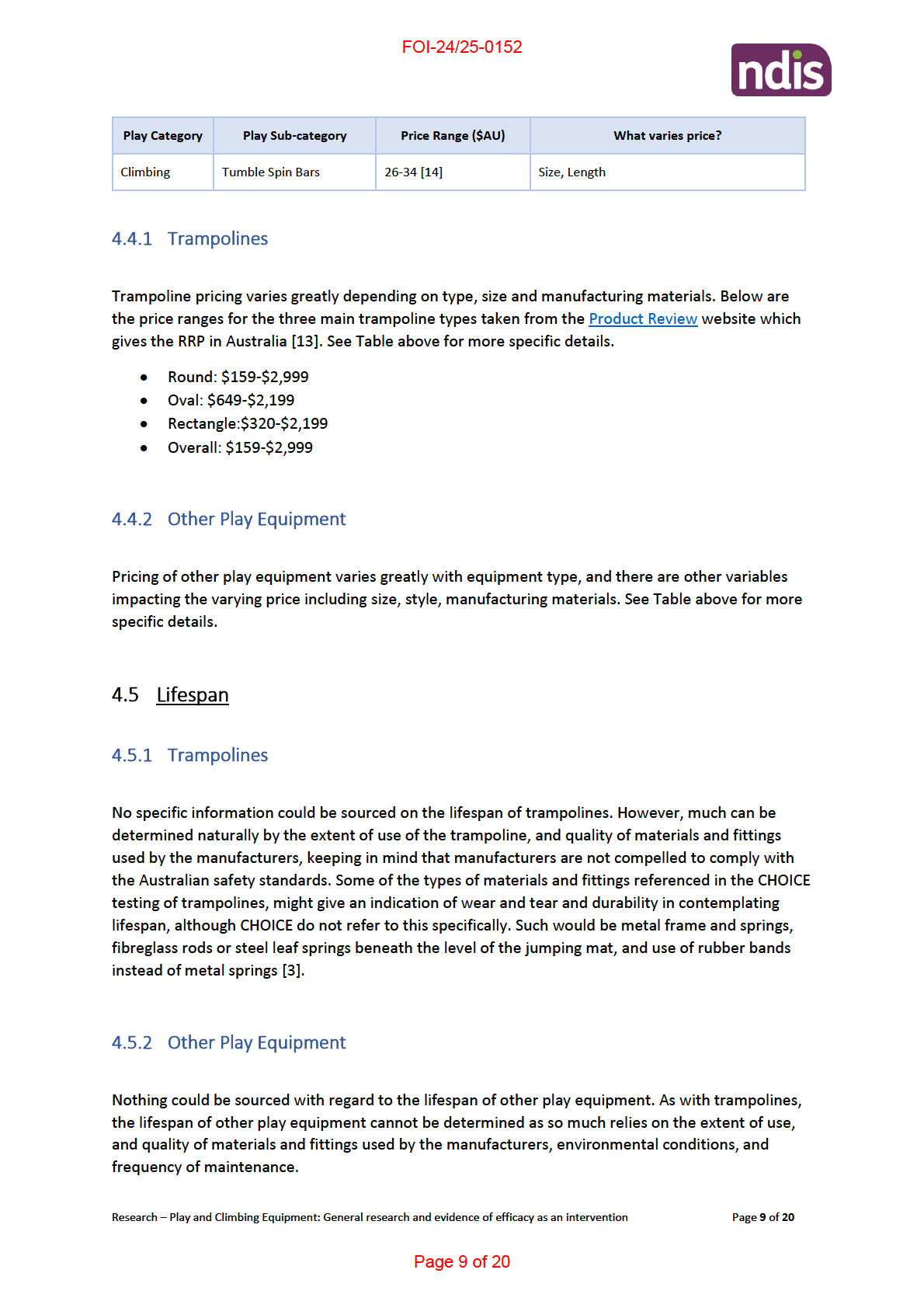

FOI-24/25-0152
Note that the Australian Standards applicable to toys and play equipment suggest the safety
standard is “
taking into account normal use and reasonably foreseeable abuse” [17].
4.6
Maintenance
4.6.1
Trampolines
Maintenance information for trampolines was gleaned from a variety of websites. Where reference
is made to replacement materials or fittings, it should be kept in mind that some of these websites
are sales oriented.
Various businesses offer regular maintenance check/makeover at cost, such as the Australian Mr
Trampoline [18] and Springfree Trampolines [19].
• Cleaning: To use a trampoline for extended times, you need to clean the trampoline
regularly or weekly or monthly depending upon your using frequency. If dust and debris
make crowds over the mat eventually it can damage the mat or springs [20]
• Regular inspection of frame: can come loose and you just need to tighten a few screws [21]
• Missing or broken springs: need to replace them before the trampoline is used [21]
• Squeakiness or noises coming from frame: lubricant required on the joints and springs [21]
• Safety nets and safety padding: can tear [21]
• Replacements: Safety nets should be replaced every two years, Safety foam should be
replaced every two years, Safety pads should be replaced every three to four years,
Trampoline frames should be replaced every 10 years [22]
• Mat Care/Maintenance General: Exposure to environmental conditions - To ensure the mat
lasts as long as possible, it is important to keep the mat clear of residue – remove leaf litter
and twigs from the mat before jumping, wash the mat down with a mild dishwashing
detergent [23]
• Mat Care/Maintenance String: To prolong the life of a 2-string mat, it should be repainted
about every 12 months (depending on weather conditions) [23]
• Mat Care/Maintenance Poly mesh: Over time, normal wear and tear, prolonged use and
exposure to environmental conditions may cause mat stitching thread to break and unravel
and fraying around the mat wires [23]
4.6.2
Other Play Equipment
Research – Play and Climbing Equipment: General research and evidence of efficacy as an intervention Page
10 of
20
Page 10 of 20

FOI-24/25-0152
There is an abundance of information on the internet offering advice to consumers with regard to
care and maintenance of residential play equipment, in terms of maintaining lifespan and safety,
where generally the advice is that equipment should be checked regularly and parts should be
replaced if necessary. Much of the advice is offered by play equipment sales sites, and generally
applies to most equipment types. As an example, below is a brief overview for some check points for
swings and swing sets.
Swings & Swing Sets [24]
• "s" hooks are used widely and they should be checked for wear and tear
• The swing chain is in good condition and not excessively worn, especially at connection
points
• The connectors and chain should have free movement at all times
• Ensure safe landing surfaces and space for swings
• Attention should be given to the swings joints and connecting points
• The swing’s welds on connecting points should be checked regularly
• Wooden swings: Checking is required for sealing/sealant to stop rust and rotting, finding and
fixing splinters, staining, weathering (expanding/contracting wood), mould and rot causing
wood and structure to become unsafe [25]
4.7
Purchase Accessibility
Internet searching indicates that there is very good accessibility for families to source, acquire
knowledge and purchase play equipment, including trampolines. There are many Australian
websites to purchase from which give detailed information about the product, and make themselves
available for contact over the phone if someone should want to purchase online. There are also
abundant showroom opportunities to view and purchase trampolines.
Below is a list of the biggest and most popular trampoline brands available in Australia as suggested
by the Australian consumer review and comparison website Canstar Blue [26]. There are an
abundance of distributor businesses across Australia, which include Bunnings and Kmart, who may
sell these major brands as well as other brands.
• Vuly Trampolines
• Springfree Trampolines
• Plum Trampolines
• Oz Trampolines
4.8
Ownership by Australian Households
There is little statistical information available on the ownership of play equipment in Australian
households. Two ABS surveys were sourced which are very dated and this should be kept in mind
when reading the data.
In 2001 a survey [27] was conducted on selected households in Queensland in order to provide data
to assist the Queensland Government to run targeted awareness campaigns and enable the
Research – Play and Climbing Equipment: General research and evidence of efficacy as an intervention Page
11 of
20
Page 11 of 20

FOI-24/25-0152
development of other intervention/prevention strategies and projects. Information was collected on
selected household safety features and potential hazards in the home.
• There were 271,300 households (19.2%) with
playground equipment
• The most popular type of playground equipment amongst these households were
swings
(188,400 or 69.5%) followed by
trampolines (132,400 or 48.8%)
In 1999 a similar survey was conducted in Victorian households [28]. Surveyed was 234,100
households with young children resident and 1,500,000 households with no young children resident.
The following table [28] indicates the results for all households with playground equipment, where
the most popular type was swings, trampolines, slides and climbing equipment in that order.
Research – Play and Climbing Equipment: General research and evidence of efficacy as an intervention Page
12 of
20
Page 12 of 20

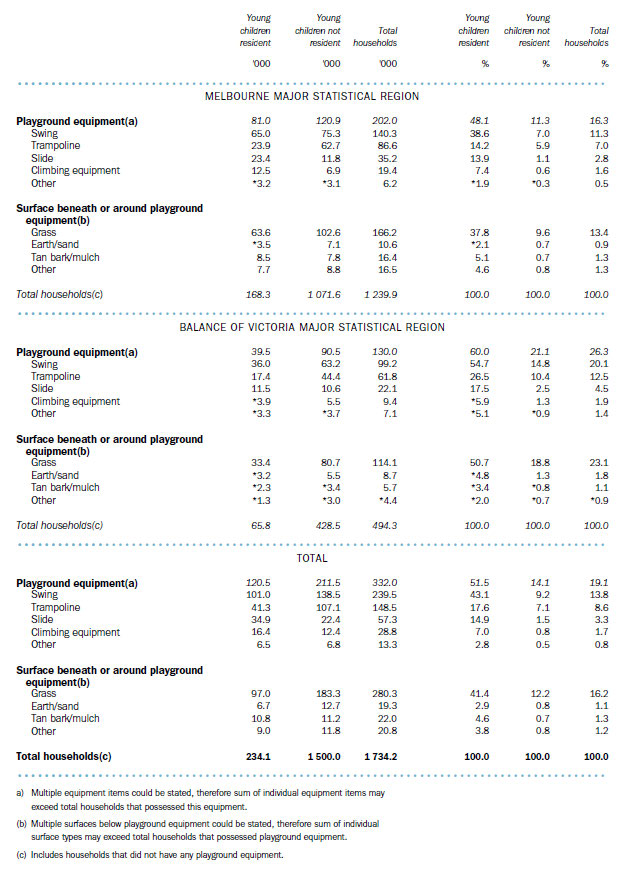
FOI-24/25-0152
Research – Play and Climbing Equipment: General research and evidence of efficacy as an intervention Page
13 of
20
Page 13 of 20

FOI-24/25-0152
5 Community Playgrounds
5.1
Australian Standards
The Australian Standard applicable to access and mobility to community parks for people with a
disability is
the Australian Standard AS 1428: Design for access and mobility, which has five
components [29]:
• Part 1 - General requirements for access - New building work
• Part 2 - Enhanced and additional requirements - Building and facilities
• Part 3 - Requirements for children and adolescents with physical disabilities
• Part 4 - Means to assist the orientation of people with vision impairment – Tactile ground
surface indicators
• Part 5 - Communication for people who are deaf or hearing impaired
This standard is not law, or mandatory [30].
The objective of
the Australian Standard AS 4685.0:2017, Playground equipment and surfacing –
Part 0: Development, installation, inspection, maintenance and operation, is to minimise the risk of
injury to playground users by [31]:
• Providing designers, owners and operators of playgrounds with guidance on the
development, installation, inspection, maintenance and operation of playgrounds.
• Creating the foundation for all Australian playground equipment and surfacing standards
• Introducing a risk benefit analysis technique that allows operators and owners of
playgrounds to quantify their exposure to hazards using techniques that are simple to apply.
Then they can make evidence-based decisions with regard to the maintenance, repairs and
the timely replacement of their assets
These standards are not law, or mandatory [32]. The other parts of the AS 4685 series specify
equipment requirements and test methods as follows [1]:
• Part 1 – General safety requirements & test methods
• Part 2 – Additional specific safety requirements & test methods for swings
• Part 3 - Additional specific safety requirements & test methods for slides
• Part 4 - Additional specific safety requirements & test methods for runways
• Part 5 - Additional specific requirements & test methods for carousels
• Part 6 - Additional specific requirements & test methods for rocking equipment
• Part 11 - Additional specific safety requirements & test methods for spatial networks
There is an abundance of information on the internet offering advice to councils and community
playground operators with regard to the importance of care and maintenance of grounds and play
equipment. There are also businesses offering at cost services for maintenance and standards checks
[33, 34].
Research – Play and Climbing Equipment: General research and evidence of efficacy as an intervention Page
14 of
20
Page 14 of 20

FOI-24/25-0152
5.2
Statistical Information
There is no consolidated statistical information available on community play grounds with regard to
fenced play areas, disability specific equipment, shaded areas, and frequency of use.
5.3
Maintenance and Safety
Unlike residential play equipment, community play equipment and park design have standards
which are to be met by the local authority. There are private businesses which consult in this area as
well as checking and auditing of general maintenance for safety.
5.4
Development of Inclusive Playgrounds in Australia
Recent years has seen state and local government paying more attention to the design of
community parks and accessibility, and this had come about mainly as a result of lobby groups [35].
For example, one main NSW lobby group Play for All Australia, is helping to educate councils across
the states. Their aim is for all councils to start from a point of inclusion when it comes to any
playground upgrade [35, 36]. Play Australia is the peak national advocacy organisation for "play"
[37].
5.4.1
Visitation
While some statistical information is available for consumer visits to state and national parks,
nothing could be sourced for local community parks and play grounds.
A very recent 2021 Australian study [38] aimed to examine the perceived importance of a selection
of park features for encouraging park visitation, park-based physical activity and social interaction
among children.
Participants (n = 272, 9.6 ± 1.1 years, 51 % female) attending primary schools in Melbourne, Australia
completed a survey during school time. They rated (from 1 to 10) digital images of 42 park features
according to how much each feature would make them want to “visit the park”, “be active in the
park” and “be with other people in the park”. Mean rating scores were calculated for the whole
sample, and separately for males and females. For each condition (visit, active, social), each feature
was then assigned a ranking from 1 to 42.
• A large adventure playground was the highest rated image for all three outcomes.
• The next highest rated images were: a giant slide and interactive areas for park visitation; an
obstacle course and giant slide for park-based physical activity; and interactive areas and an
obstacle course for social interaction.
Research – Play and Climbing Equipment: General research and evidence of efficacy as an intervention Page
15 of
20
Page 15 of 20

FOI-24/25-0152
• Many differences in ratings were observed by gender, highlighting the importance of
considering all demographic groups.
In the participant rating for park feature reasons for visiting a park,
climbing featured in the top of
42 [38]:
1. Large adventure playground
2. Giant slide
3. Interactive areas (e.g. statues that light up with colours or make sounds when touched)
4. Obstacle course/parkour area
5. Flying fox
6. Things to climb
7. Water play area
8. Long slide
9. Large swings
10. Trees for climbing
5.4.2
Fencing
The advocacy organisation Play Australia suggests that "there is no Standard on playground fencing,
and there is no likelihood of there being one in Australia" [39]. The group in conjunction with the
Department of Sport & Recreation Victoria has produced The Good Playspace Guide which examines
the reasons why play spaces can limit access to some children and identify how improvements can
be made to increase participation by all children in play [40].
5.5
Tools to locate local community play grounds
5.5.1
Searching the internet for local community playgrounds
As there is no one internet source which provides Australia wide playground listings, a simple google
search by state can give a good result of links to council/shire parks. For example by using the search
string “victoria playgound directory”.
The following method can also be used to locate playgrounds in a specific local community:
1. Use one of the links in the table below, and search by the post code or suburb, to locate the
local government area and the link to the local government website.
2. Search the local government website for community parks. Most local government websites
should list their parks, give details about each park, and may also indicate if the park is
inclusive. If there are no parks listed, a phone call can be made.
Research – Play and Climbing Equipment: General research and evidence of efficacy as an intervention Page
16 of
20
Page 16 of 20
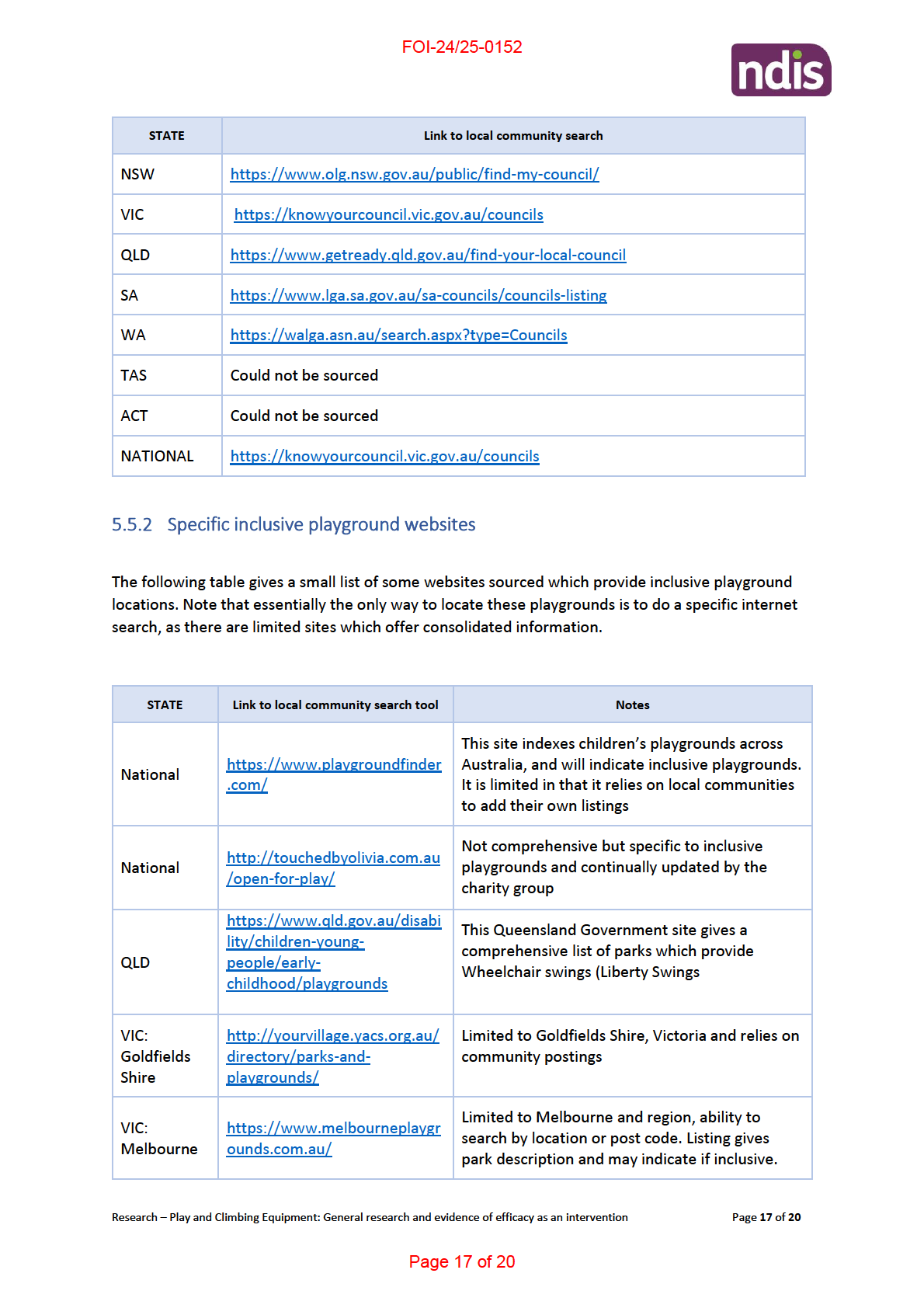

FOI-24/25-0152
6 References
1.
KidSafe NSW Inc. Australian Standards for Playgrounds 2012 [Available from:
https://www.kidsafensw.org/playground-safety/playground-standards/.
2.
Standards Australia. Trampolines for domestic use - Safety aspects (AS 4989:2015) 2021
[Available from: https://www.standards.org.au/standards-catalogue/sa-snz/other/cs-100/as--4989-
colon-2015.
3.
CHOICE. How to buy a safe trampoline 2021 [Available from:
https://www.choice.com.au/babies-and-kids/children-and-safety/toys-and-safety-at-play/buying-
guides/trampolines.
4.
CHOICE. Springfree model tops trampoline test as others face safety concerns 2021
[Available from: https://www.choice.com.au/babies-and-kids/children-and-safety/toys-and-safety-
at-play/articles/springfree-tops-trampoline-test.
5.
CHOICE. Springfree R79 Medium Round review 2021 [Available from:
https://www.choice.com.au/products/babies-and-kids/children-and-safety/toys-and-safety-at-
play/springfree-r79-medium-round.
6.
Standards Australia. Safety of toys, Part 6: Swings, slides and similar activity toys for indoor
and outdoor family domestic use (ISO 8124-4:2014, MOD) 2016 [Available from:
https://www.standards.org.au/standards-catalogue/sa-snz/other/cs-018/as-slash-nzs--8124-dot-6-
colon-2016.
7.
Australian Competition and Consumer Commission. Toys for children up to and including 36
months of age [Available from: https://www.productsafety.gov.au/standards/toys-for-children-up-
to-and-including-36-months-of-age.
8.
Trampoline Choice. A Quick Guide to Height and Weight Limits on Trampolines 2018
[Available from: https://www.trampolinechoice.com/quick-guide-height-weight-limits-trampolines/.
9.
Simple Trampoline. How Much Weight Can A Trampoline Hold? 2021 [Available from:
https://simpletrampoline.com/how-much-weight-can-a-trampoline-hold/.
10.
Skybound. 7 Things to Know About Round vs. Rectangular Trampolines 2021 [Available from:
https://www.skyboundusa.com/blogs/trampoline-resources/round-vs-rectangular-trampolines.
11.
Springfree Trampoline. 6 Things You Need to Know Before Buying a Trampoline 2021
[Available from: https://www.springfreetrampoline.com.au/blog/2017/06/27/6-things-you-need-
know-buying-
trampoline#:~:text=Here%20are%20our%20recommendations%20to%20find%20the%20best,installi
ng%20where%20the%20slope%20is%20greater%20than%20that%29.
12.
Child Safety Hub. Outdoor Safety - Playground Safety 2020 [Available from:
http://nsw.childsafetyhub.com.au/outdoor-safety-playground-safety/.
13.
Product Review. Best Trampolines 2021 [Available from:
https://www.productreview.com.au/c/trampolines#what-age-is-it-safe-to-jump-on-a-trampoline-3.
14.
Play Equipment & Accessories. Residential Products 2021 [Available from:
https://playequipment.com.au/.
15.
Bunnings Wharehouse. Outdoor Play Equipment 2021 [Available from:
https://www.bunnings.com.au/our-range/outdoor-play.
16.
Funky Monkey Bars. Flying Foxes 2021 [Available from:
https://www.funkymonkeybars.com/products/flying-fox.
17.
Sai GLobal. AS/NZS ISO 8124.1:2019 2021 [Available from:
https://infostore.saiglobal.com/en-us/standards/as-nzs-iso-8124-1-2019-
115604 saig as as 2732314/.
18.
Mr Trampoline. Trampoline Care 2021 [Available from:
https://www.mrtrampoline.com.au/trampoline-care/.
Research – Play and Climbing Equipment: General research and evidence of efficacy as an intervention Page
18 of
20
Page 18 of 20

FOI-24/25-0152
19.
Springfree Trampoline. Health Check 2021 [Available from:
https://www.springfreetrampoline.com.au/trampoline-care-maintenance.
20.
True Trampoline. Trampoline Care and Trampoline Maintenance: Ultimate Techniques
Revealed! 2021 [Available from: https://truetrampoline.com/trampoline-care-and-trampoline-
maintenance/#:~:text=Trampoline%20Cleaning&text=You%20should%20remove%20leaves%2C%20
dust,lead%20to%20the%20frame's%20erosion.
21.
Web and Warehouse. Trampoline care & maintenance - so simple even kids can do it 2021
[Available from: https://webandwarehouse.com.au/blog/Trampoline-Maintenance.
22.
Vuly. Trampoline Maintenance Tips 2021 [Available from: https://www.vulyplay.com/en-
AU/blog/trampoline-maintenance-tips.
23.
Durable Products Australia Pty Ltd. Trampoline Maintenance 2021 [Available from:
https://www.durableproducts.com.au/trampolines/maintenance/.
24.
Play Equipment. 12 Easy Ways for Playground Swing Set Maintenance 2021 [Available from:
https://www.playgroundequipment.com/playground-swing-set-maintenance/.
25.
Adventure World Play Sets. How Much Maintenance Does a Wooden Playset or Swing Set
Need? 2021 [Available from: https://www.adventureworldplaysets.com/blog/planning-your-
playset/wooden-playset-maintenance.
26.
Canstar Blue. Jump for joy: A guide to trampolines 2016 [Available from:
https://www.canstarblue.com.au/family-gifts/jump-joy-guide-trampolines/.
27.
Australian Bureau of Statistics. 4387.3 - Safety in the Home, Queensland, Oct 2001 2001
[Available from:
https://www.abs.gov.au/ausstats/abs@.nsf/PrimaryMainFeatures/4387.3?OpenDocument.
28.
Australian Bureau of Statistics. 4387.2 - Safety In The Home Victoria 1999 [Available from:
https://www.ausstats.abs.gov.au/ausstats/subscriber.nsf/0/CA25687100069892CA256888001F394C
/$File/43872 Oct%201998.pdf.
29.
Australian Standards. ME-064 - Access for People with Disabilities 2016 [Available from:
https://www.standards.org.au/standards-catalogue/sa-snz/building/me-064
30.
Obvius Access Consultants and Designers. Australian Standard (AS 1428-Design for Access
and Mobility) [Available from: https://www.accessconsultant.com.au/as-1428---design-for-access-
and-mobility.html.
31.
Australian Standards. New Australian Standard for Playground Safety 2017 [Available from:
https://www.standards.org.au/news/new-australian-standard-for-playground-safety.
32.
Play Australia. Planning for safe outoor play in children’s services [Available from:
https://www.playaustralia.org.au/sites/default/files/LibraryDownloads/Planning%20for%20Safe%20
Outdoor%20Play%20in%20Childrens%20Services.pdf.
33.
Play Care. PlayCare Provides Playground Equipment Compliance [Available from:
https://playcare.net.au/ourservices/playground-compliance/.
34.
PLayright Australia. Playground Inspection Services 2021 [Available from:
https://www.playright.com.au/services/lorem-ipsum-dolor-sit-amet-consectetur-adipiscing-elit-
nam-non-justo-sed-purus-varius-rutrum-auctor-viverra-libero-praesent-eget-mauris-at-eros-feugiat-
viverra/.
35.
Mable. What is an inclusive playground, and where to find the best in Australia? 2019
[Available from: https://mable.com.au/newsroom/what-is-an-inclusive-playground-and-where-to-
find-the-best-in-australia/.
36.
Play For All Australia. About Us 2021 [Available from:
https://playforall.com.au/index.php/about-us/.
37.
Play Australia. About Us 2020 [Available from: https://www.playaustralia.org.au/about-us.
38.
Veitch J, Ball K, Flowers E, Deforche B, Timperio A. Children’s ratings of park features that
encourage park visitation, physical activity and social interaction. Urban Forestry & Urban Greening
Research – Play and Climbing Equipment: General research and evidence of efficacy as an intervention Page
19 of
20
Page 19 of 20

FOI-24/25-0152
[Internet]. 2021 2021/03/01/; 58:[126963 p.]. Available from:
https://www.sciencedirect.com/science/article/pii/S1618866720307809.
39.
Play Australia. FENCING AND PUBLIC PLAYSPACES ? [Available from: FENCING AND PUBLIC
PLAYSPACES
40.
Department for Victorian Communities. The Good Play Space Guide: “I Can Play Too” 2007
[Available from:
https://www.playaustralia.org.au/sites/default/files/LibraryDownloads/The%20Good%20Play%20Sp
ace%20Guide%20I%20Can%20Play%20Too.pdf.
Research – Play and Climbing Equipment: General research and evidence of efficacy as an intervention Page
20 of
20
Page 20 of 20




















